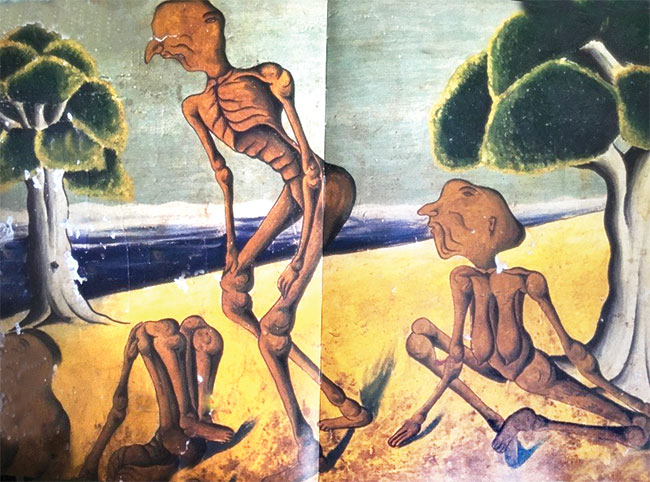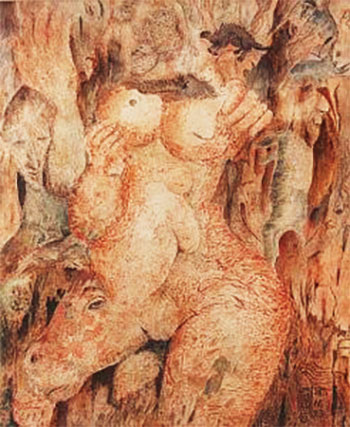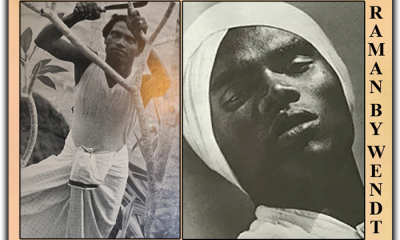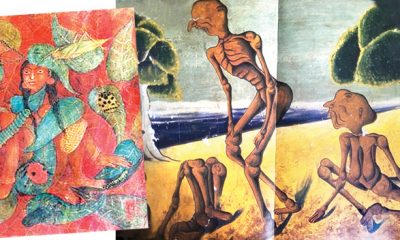Features
An Imaginary Museum or a Museum Without Walls:

David Paynter and L.T.P. Manjusri
(Part one of this article appeared in Midweek Review yesterday.)
by Laleen Jayamanne
Eclecticism and Abstraction
It would appear that a book or two might be written about the lesser known history of 20th Century Lankan modern art and visual culture, which seems to be much wider than the art historical accounts of 43 Group Modernism. There must be many others as well. For example, one comes across the name of H.A. Karunaratne as an abstract painter influenced by Euro-American abstraction as having held a solo exhibition in 1956 at the USISC. What response did this exhibition receive in that momentous year of the triumph of Sinhala-Buddhist Nationalist exceptionalism after Sir John Kothalawala’s pro-American government was defeated. Then there is the Ian Goonatilake collection bequeathed to the University of Peradeniya and now languishing in the basement of the library, stored under poor conditions, awaiting a dedicated gallery. While it is well known that his collection consists of a large number of George Keyt drawings because of his wide taste and sympathies his collection might hold potential for considering a somewhat decentred (less linear), art historical narratives of the twentieth century. The blatantly self-interested, thin accounts that pass as recent art history can thereby be displaced by more careful art historical research with rigorous conceptual frameworks. The history of the use of colour in the move from the Buddhist temple paintings to the easel and then from easel to Christian church walls and back as in the case of Paynter would be fascinating to explore within a theoretical framework. Such a framework might explore the generative philosophico-aesthetic discourses on the links between colour, affect and thought, for example. There, colour is considered to be the most immaterial manifestation of matter, haunted by spirit. Colour within such an optic is a force of metamorphosis.
Christian Themes
Christian themed art also would have to be explicitly taken into account in the narrative of Lankan modern art when studying Paynter’s work. What links might there be, say, between Richard Gabriel and Paynter who composed Christian religious scenes in murals in chapels, too. It is certainly noteworthy that in the large murals he created in the Trinity College chapel in the ‘30s, Paynter’s Jesus and disciples are presented with brown skin tones. This fact alone is the decision of an original artist because it was decades prior to the radical Vatican 2 reforms of the ’60s, which lead to adopting vernacular forms and realities in Catholic Church ritual. The vegetation and light in the landscapes of some biblical scenes are those of Lanka of the East coast, I am told. Chandrajeewa, too, has done a large scale series of 46 bronze murals on the history of Christianity in Lanka around the Basilica on a hill top at Thewatta (surrounded by rubber trees, as I remember from my school visits there for church feasts) near Ragama though he himself does not subscribe to any religious faith. Barbara Sansoni’s Christian murals would be of interest in such a context. A national collection can create digital installations of site-specific religious work such as these to educate Lankans about the religious diversity of our art and culture as well. Inter-faith dialogue would certainly be enhanced by such educational ‘tools’ made available to school-children especially, but also to the more ethnocentric and parochial Lankans. It could then also be a point of entry to understanding something about our long colonial history and religious violence of the Portuguese who converted Lankans at gunpoint. Both my parents and grandparents came from the thin strip of coastal fishing villages (just a stones throw from the Colombo harbour), starting from Uswatakeiyawa, Kapungoda and Pamunugama, all mostly Roman Catholic, during my childhood. The largest buildings in each of these villagers were the local churches built on Italian models with large statues of white saints, mother Mary and Jesus. There were a few French parish priests who also spoke fluent Sinhala.
A Queer Aesthetic: Exploring the +

Evolution 1973 L.T.P. Manjusri (1902-1982)
Water colour on Paper 36.5 X 31 cm
Image Credits : http://www.artsrilanka.org/retrospective/manjushri/19731.html
Is there an embryonic queer sensibility, and a radical aesthetic, in Paynter’s ‘Offering’ (1926), of an ethereal youth, standing naked in a dreamy, somewhat Pre-Raphaelit landscape, with raised arms, delicate hand gesture, holding a white flower, for instance? Perhaps, there are ‘elective affinities’ to be drawn between Wendt’s homo erotic photography of young men and some of Paynter’s work. Or, are their differences more productive for exploring the diversity of queer aesthetics well before such a term was invented to address social reality of LGBTQI rights? Paynter’s ‘Apres Midi’ (‘Afternoon’, 1935) is an astonishing work full of surprises, even now. The inclusion of the title in French immediately evokes the 1911 ballet ‘Afternoon of a Faun’ choreographed and performed by Nijinsky in his lover Diaghilev’s company, Ballet Russes, in Paris, with Debussy’s music. Apart from that notable allusion to a highly sexualised performance that shocked the traditional ballet audience, the two Lankan figures, one facing us, and the other, appears to be his double, a mirror image, though all we do see is his back view. There is an essay to be written about this doubling and elegant most subtle ‘performance of narcissism,’ in the sense of an exploration of a queer subjectivity, the very formation of a sense of ‘self’ based on similarity rather than sexual difference. The facial expression of the slim tall figure (so unlike Nijinsky’s muscular compact short body), is thoughtful, as he looks at ‘the other’ and his features suggest that he might be a Lankan of Malay descent perhaps. As with ‘Offering’, here too the male figure holds a red flower, reminiscent of the distilled eroticism seen in Moghul miniatures. In Paynter’s tropical ‘Afternoon’ there is a more every-day feel as well because of the towels and informal postures – are ‘they’ about to swim in the river behind them? The blue green bamboo grove creates a lush tropical heaven for ‘the couple’. Might we think of it as a queer self-portrait perhaps? If so it’s quite different from his earlier, personal ‘Self-Portrait’ (1927), where the ‘self’ is decentred, seen in a mirror image, while a vase of overflowing pink lotus blossoms occupies the centre. As early as that, he is painting the iconic flower in Buddhist iconography, rather than the readily available English roses of Nuwara-Eliya which is where the Paynter Home was located.
Then there is the painting of a group of fishermen and male onlookers after a catch. While some onlookers are fully clothed, the two fishermen in the foreground are conspicuous not because they wear only loin cloths (which is realistic) but because of the way their anatomy is modelled.
The anatomy of the two prominent fishermen are modelled in such a way that their biceps, pectoral and abdominal muscles are beautifully articulated. Lankan men who do heavy manual work have wiry limbs, sinewy muscles, a function of diet and genetics, they are certainly not moulded and fashioned quite like those on these two fishermen. Though these conspicuous muscular details are not realistic, the scene nevertheless has a powerful ethnographic vitality. The choreography of each gaze has an intensity, a realism, as each figure looks intently in slightly different directions. Their features evoke a specific Lankan era. I remember the men who looked like that in my maternal grandfather’s fishing village, Uswatekeiyawa. My grandfather tied his hair in a little knot just like some of them in the picture.
Wendt’s photographs of young men’s bodies are quite different. Their gaze is rather more diffused. It’s his play with and command of light and shade and chemical processing that sculpts their bodies, either caught straining in manual work or relaxed in posed still lives. In striking contrast, Paynter has given his standing fishermen a deep, anatomically grounded musculature that feels so contemporary in its fashioning, sculpting of desire. Thereby, he helps us (straight folk also) to understand how a Queer sensibility is crafted and invented as a fertile affective zone of aesthetic innervation, which also includes nature. These two paintings have a quiet theatrical and even cinematic sensibility (i. e. there is movement and drama), which reminds me of Pier Paolo Pasolini’s cinema, especially Gospel According to St Mathew. Pasolini however, was a flamboyantly public gay artist and poet. I feel that Paynter’s work offers young LGBTQI+ artists a vital tradition to draw from, not imitate. Some of them might have been at that Gay Pride March in Colombo sponsored by the Aragalaya recently, which I saw on You Tube. I hear Paynter the teacher say, ever so softly: ‘explore the +’. With just a slight turn, artists may change the + into an x.
These are thoughts that occur to me as I glance at Paynter’s work in the catalogue edited by Chandrajeewa, issued at the inaugural J.D.A. Perera Gallery, which houses 19 of Paynter’s work at the University of Visual and Performing Arts. But ‘The Afternoon’, sadly, is in a foreign gallery. This rare gift was given to the very institution whose Sinhala-Buddhist nationalist students and staff got rid of Paynter in 1963, through an ugly racist campaign against him, calling him a ‘Burgher suddha’!
I know that Professor Ashley Halpe, himself a painter, introduced Paynter’s art to students of Fine Arts at Peradeniya University and accompanied them to the Trinity College Chapel to look at the murals Paynter had designed in the 1930s. By the way, Prof Halpe was a Roman Catholic, who nurtured extracurricular student life on campus generously with an open house filled with painting and music every Friday, enthusiastically supported by his wife Bridgette.
What is to be Done?
I hope young Lankan art historians might take a cue from the marvellous idea of the ‘Memory Walks’ conducted by the ‘Collective for Historical Dialogue and Memory’ and go off the beaten track to find out what was made; what has been lost and the provenance of work that really should have been in a national collection but are now in private homes and overseas galleries and in damp basements, even locked away in a vault. Perhaps, only such dedicated hands-on work by scholars with intellectual and social capital and spiritual stamina might eventually convince the National Museum to open one of its majestic wings to house whatever is left of modern 20th Century art and Visual Culture of a multi-ethnic, multi-religious Lanka. On the other hand, as some folk in the Aragalaya suggested, perhaps the official residence of the President, which was formerly known as the Queens’s House but has become the President’s House, can be converted like the European palaces into a museum of modern and contemporary art and the art work of the Aragalaya too.
Perhaps, an archive of photographs of work that has been sold or stolen or unavailable in the public domain can be compiled digitally just so that future generations of artists might get to know the eclectic variety of work that had been created by their multi-ethnic, multi-faith, queer and straight ‘ancestors.’ Then, they might begin to understand deeply some of the ideas and passions which animated the skilled and dedicated modern Lankan artists of the 20th and 21st Centuries. Such a virtual collection might be called following the famous idea of French Minister of Culture Andre Malraux, ‘An Imaginary Museum’ or ‘Museum Without Walls.’ Such a museum would, I hope, assemble an eclectic (non-partisan), collection of art- work with the power to nurture life in a multi-ethnic, multi-cultural, multi-faith Lanka.
Here is a link to Paynter’s Apres Midi (Afternoon, 1935).
https://thuppahis.com/2022/03/27/david-paynters-open-homosexuality-on-display- then/
Features
People set example for politicians to follow

Some opposition political parties have striven hard to turn the disaster of Cyclone Ditwah to their advantage. A calamity of such unanticipated proportions ought to have enabled all political parties to come together to deal with this tragedy. Failure to do so would indicate both political and moral bankruptcy. The main issue they have forcefully brought up is the government’s failure to take early action on the Meteorological Department’s warnings. The Opposition even convened a meeting of their own with former President Ranil Wickremesinghe and other senior politicians who shared their experience of dealing with natural and man-made disasters of the past, and the present government’s failures to match them.
The difficulty to anticipate the havoc caused by the cyclone was compounded by the neglect of the disaster management system, which includes previous governments that failed to utilise the allocated funds in an open, transparent and corruption free manner. Land designated as “Red Zones” by the National Building Research Organisation (NBRO), a government research and development institute, were built upon by people and ignored by successive governments, civil society and the media alike. NBRO was established in 1984. According to NBRO records, the decision to launch a formal “Landslide Hazard Zonation Mapping Project (LHMP)” dates from 1986. The institutional process of identifying landslide-prone slopes, classifying zones (including what we today call “Red Zones”), and producing hazard maps, started roughly 35 to 40 years ago.
Indonesia, Thailand and the Philippines which were lashed by cyclones at around the same time as Sri Lanka experienced Cyclone Ditwah were also unprepared and also suffered enormously. The devastation caused by cyclones in the larger southeast Asian region is due to global climate change. During Cyclone Ditwah some parts of the central highlands received more than 500 mm of rainfall. Official climatological data cite the average annual rainfall for Sri Lanka as roughly 1850 mm though this varies widely by region: from around 900 mm in the dry zones up to 5,000 mm in wet zones. The torrential rains triggered by Ditwah were so heavy that for some communities they represented a rainfall surge comparable to a major part of their typical annual rainfall.
Inclusive Approach
Climate change now joins the pantheon of Sri Lanka’s challenges that are beyond the ability of a single political party or government to resolve. It is like the economic bankruptcy, ethnic conflict and corruption in governance that requires an inclusive approach in which the Opposition, civil society, religious society and the business community need to join rather than merely criticise the government. It will be in their self-interest to do so. A younger generation (Gen Z), with more energy and familiarity with digital technologies filled, the gaps that the government was unable to fill and, in a sense, made both the Opposition and traditional civil society redundant.
Within hours of news coming in that floods and landslides were causing havoc to hundreds of thousands of people, a people’s movement for relief measures was underway. There was no one organiser or leader. There were hundreds who catalysed volunteers to mobilise to collect resources and to cook meals for the victims in community kitchens they set up. These community kitchens sprang up in schools, temples, mosques, garages and even roadside stalls. Volunteers used social media to crowdsource supplies, match donors with delivery vehicles, and coordinate routes that had become impassable due to fallen trees or mudslides. It was a level of commitment and coordination rarely achieved by formal institutions.
The spontaneous outpouring of support was not only a youth phenomenon. The larger population, too, contributed to the relief effort. The Galle District Secretariat sent 23 tons of rice to the cyclone affected areas from donations brought by the people. The Matara District Secretariat made arrangements to send teams of volunteers to the worst affected areas. Just as in the Aragalaya protest movement of 2022, those who joined the relief effort were from all ethnic and religious communities. They gave their assistance to anyone in need, regardless of community. This showed that in times of crisis, Sri Lankans treat others without discrimination as human beings, not as members of specific communities.
Turning Point
The challenge to the government will be to ensure that the unity among the people that the cyclone disaster has brought will outlive the immediate relief phase and continue into the longer term task of national reconstruction. There will be a need to rethink the course of economic development to ensure human security. President Anura Kumara Dissanayake has spoken about the need to resettle all people who live above 5000 feet and to reforest those areas. This will require finding land for resettlement elsewhere. The resettlement of people in the hill country will require that the government address the issue of land rights for the Malaiyaha Tamils.
Since independence the Malaiyaha Tamils have been collectively denied ownership to land due first to citizenship issues and now due to poverty and unwillingness of plantation managements to deal with these issues in a just and humanitarian manner beneficial to the workers. Their resettlement raises complex social, economic and political questions. It demands careful planning to avoid repeating past mistakes where displaced communities were moved to areas lacking water, infrastructure or livelihoods. It also requires political consensus, as land is one of the most contentious issues in Sri Lanka, tied closely to identity, ethnicity and historical grievances. Any sustainable solution must go beyond temporary relocation and confront the historical exclusion of the Malaiyaha Tamil community, whose labour sustains the plantation economy but who remain among the poorest groups in the country.
Cyclone Ditwah has thus become a turning point. It has highlighted the need to strengthen governance and disaster preparedness, but it has also revealed a different possibility for Sri Lanka, one in which the people lead with humanity and aspire for the wellbeing of all, and the political leadership emulates their example. The people have shown through their collective response to Cyclone Ditwah that unity and compassion remain strong, which a sincere, moral and hardworking government can tap into. The challenge to the government will be to ensure that the unity among the people that the cyclone disaster has brought will outlive the immediate relief phase and continue into the longer term task of national reconstruction with political reconciliation.
by Jehan Perera
Features
An awakening: Revisiting education policy after Cyclone Ditwah

 In the short span of two or three days, Cyclone Ditwah, has caused a disaster of unprecedented proportions in our midst. Lashing away at almost the entirety of the country, it has broken through the ramparts of centuries old structures and eroded into areas, once considered safe and secure.
In the short span of two or three days, Cyclone Ditwah, has caused a disaster of unprecedented proportions in our midst. Lashing away at almost the entirety of the country, it has broken through the ramparts of centuries old structures and eroded into areas, once considered safe and secure.
The rains may have passed us by. The waters will recede, shops will reopen, water will be in our taps, and we can resume the daily grind of life. But it will not be the same anymore; it should not be. It should not be business as usual for any of us, nor for the government. Within the past few years, Sri Lankan communities have found themselves in the middle of a crisis after crisis, both natural and man-made, but always made acute by the myopic policies of successive governments, and fuelled by the deeply hierarchical, gendered and ethnicised divides that exist within our societies. The need of the hour for the government today is to reassess its policies and rethink the directions the country, as a whole, has been pushed into.
Neoliberal disaster
In the aftermath of the devastation caused by the natural disaster, fundamental questions have been raised about our existence. Our disaster is, in whole or in part, the result of a badly and cruelly managed environment of the planet. Questions have been raised about the nature of our economy. We need to rethink the way land is used. Livelihoods may have to be built anew, promoting people’s welfare, and by deveoloping a policy on climate change. Mega construction projects is a major culprit as commentators have noted. Landslides in the upcountry are not merely a result of Ditwah lashing at our shores and hills, but are far more structural and points to centuries of mismanagement of land. (https://island.lk/weather-disasters-sri-lanka-flooded-by-policy-blunders-weak-enforcement-and-environmental-crime-climate-expert/). It is also about the way people have been shunted into lands, voluntarily or involuntarily, that are precarious, in their pursuit of a viable livelihood, within the limited opportunities available to them.
Neo liberal policies that demand unfettered land appropriation and built on the premise of economic growth at any expense, leading to growing rural-urban divides, need to be scrutinised for their short and long term consequences. And it is not that any of these economic drives have brought any measure of relief and rejuvenation of the economy. We have been under the tyrannical hold of the IMF, camouflaged as aid and recovery, but sinking us deeper into the debt trap. In October 2025, Ahilan Kadirgamar writes, that the IMF programme by the end of 2027, “will set up Sri Lanka for the next crisis.” He also lambasts the Central Bank and the government’s fiscal policy for their punishing interest rates in the context of disinflation and rising poverty levels. We have had to devalue the rupee last month, and continue to rely on the workforce of domestic workers in West Asia as the major source of foreign exchange. The government’s negotiations with the IMF have focused largely on relief and infrastructure rebuilding, despite calls from civil society, demanding debt justice.
The government has unabashedly repledged its support for the big business class. The cruelest cut of them all is the appointment of a set of high level corporate personalities to the post-disaster recovery committee, with the grand name, “Rebuilding Sri Lanka.” The message is loud and clear, and is clearly a slap in the face of the working people of the country, whose needs run counter to the excessive greed of extractive corporate freeloaders. Economic growth has to be understood in terms that are radically different from what we have been forced to think of it as, till now. For instance, instead of investment for high profits, and the business of buy and sell in the market, rechannel investment and labour into overall welfare. Even catch phrases like sustainable development have missed their mark. We need to think of the economy more holistically and see it as the sustainability of life, livelihood and the wellbeing of the planet.
The disaster has brought on an urgency for rethinking our policies. One of the areas where this is critical is education. There are two fundamental challenges facing education: Budget allocation and priorities. In an address at a gathering of the Chamber of Commerce, on 02 December, speaking on rebuilding efforts, the Prime Minister and Minister of Education Dr. Harini Amarasuriya restated her commitment to the budget that has been passed, a budget that has a meagre 2.4% of the GDP allocated for education. This allocation for education comes in a year that educational reforms are being rolled out, when heavy expenses will likely be incurred. In the aftermath of the disaster, this has become more urgent than ever.
Reforms in Education
The Government has announced a set of amendments to educational policy and implementation, with little warning and almost no consultation with the public, found in the document, Transforming General Education in Sri Lanka 2025 published by the Ministry of Education. Though hailed as transformative by the Prime Minister (https://www.news.lk/current-affairs/in-the-prevailing-situation-it-is-necessary-to-act-strategically-while-creating-the-proper-investments-ensuring-that-actions-are-discharged-on-proper-policies-pm), the policy is no more than a regurgitation of what is already there, made worse. There are a few welcome moves, like the importance placed on vocational training. Here, I want to raise three points relating to vital areas of the curriculum that are of concern: 1) streamlining at an early age; relatedly 2) prioritising and privileging what is seen as STEM education; and 3) introducing a credit-based modular education.
1. A study of the policy document will demonstrate very clearly that streamlining begins with Junior Secondary Education via a career interest test, that encourages students to pursue a particular stream in higher studies. Further Learning Modules at both “Junior Secondary Education” and “Senior Secondary Education Phase I,” entrench this tendency. Psychometric testing, that furthers this goal, as already written about in our column (https://kuppicollective.lk/psychometrics-and-the-curriculum-for-general-education/) points to the bizarre.
2. The kernel of the curriculum of the qualifying examination of Senior Secondary Education Phase I, has five mandatory subjects, including First Language, Math, and Science. There is no mandatory social science or humanities related subject. One can choose two subjects from a set of electives that has history and geography as separate subjects, but a Humanities/Social Science subject is not in the list of mandatory subjects. .
3. A credit-based, modular education: Even in universities, at the level of an advanced study of a discipline, many of us are struggling with module-based education. The credit system promotes a fragmented learning process, where, depth is sacrificed for quick learning, evaluated numerically, in credit values.
Units of learning, assessed, piece meal, are emphasised over fundamentals and the detailing of fundamentals. Introducing a module based curriculum in secondary education can have an adverse impact on developing the capacity of a student to learn a subject in a sustained manner at deeper levels.
Education wise, and pedagogically, we need to be concerned about rigidly compartmentalising science oriented, including technological subjects, separately from Humanities and Social Studies. This cleavage is what has led to the idea of calling science related subjects, STEM, automatically devaluing humanities and social sciences. Ironically, universities, today, have attempted, in some instances, to mix both streams in their curriculums, but with little success; for the overall paradigm of education has been less about educational goals and pedagogical imperatives, than about technocratic priorities, namely, compartmentalisation, fragmentation, and piecemeal consumerism. A holistic response to development needs to rethink such priorities, categorisations and specialisations. A social and sociological approach has to be built into all our educational and development programmes.
National Disasters and Rebuilding Community
In the aftermath of the disaster, the role of education has to be rethought radically. We need a curriculum that is not trapped in the dichotomy of STEM and Humanities, and be overly streamlined and fragmented. The introduction of climate change as a discipline, or attention to environmental destruction cannot be a STEM subject, a Social Science/Humanities subject or even a blend of the two. It is about the vision of an economic-cum-educational policy that sees the environment and the economy as a function of the welfare of the people. Educational reforms must be built on those fundamentals and not on real or imagined short term goals, promoted at the economic end by neo liberal policies and the profiteering capitalist class.
As I write this, the sky brightens with its first streaks of light, after days of incessant rain and gloom, bringing hope into our hearts, and some cheer into the hearts of those hundreds of thousands of massively affected people, anxiously waiting for a change in the weather every second of their lives. The sense of hope that allows us to forge ahead is collective and social. The response by Lankan communities, to the disaster, has been tremendously heartwarming, infusing hope into what still is a situation without hope for many. This spirit of collective endeavour holds the promise for what should be the foundation for recovery. People’s demands and needs should shape the re-envisioning of policy, particularly in the vital areas of education and economy.
(Sivamohan Sumathy was formerly attached to the Department of English, University of Peradeniya)
Kuppi is a politics and pedagogy happening on the margins of the lecture hall that parodies, subverts, and simultaneously reaffirms social hierarchies.
By Sivamohan Sumathy
Features
ABBA scene in Doha … Ishini in the spotlight

 The group ABBA, from Sweden, officially disbanded in 1982, and that made room for several ABBA imitators to come into the scene.
The group ABBA, from Sweden, officially disbanded in 1982, and that made room for several ABBA imitators to come into the scene.
What’s more, ABBA tribute concerts are also turning out to be popular with music lovers who still appreciate, and enjoy, the music of ABBA.
With this in mind, Treffen House Hotel, in Doha, decided to put together a series of ABBA Tribute Concerts which were held, in the hotel itself, on 27th, 28th and 29th November, 2025.
To do the needful, on stage, they selected our very own Ishini Fonseka and her participation certainly did highlight the global appeal of ABBA’s music and the talent of Sri Lankan artistes.
The tribute shows brought the magic of ABBA’s hits to the audience,

On stage belting out the ABBA hits
Backed by a Sri Lankan band, the Vibes, based in Qatar, Ishini was in the spotlight for one hour, each night, belting out the hits of ABBA.
She also obliged the audience, from various nationalities, with a few hit songs in Hindi, Tamil and Sinhala.
Her repertoire included the best of ABBA hits, such as ‘Mamma Mia’, ‘Dancing Queen’, ‘Chiquitita’ and many more.
Being a multi-instrumentalist, she also played the piano, and guitar, as well, while singing some of the beautiful ABBA songs.
The three-day concert was a part of a Sri Lankan food festival, held at the hotel, in which several unique Sri Lankan cuisines were promoted internationally.
The event’s main sponsor was Prime Lands, and the event focused on the importance of investing on Real Estate, especially since the foreign currency sent to Sri Lanka benefits the country’s economy vastly.
Kumudu Fonseka, the General Manager of Treffen House Hotel, the main man behind the spectacular three-day Sri Lankan Food Festival, I’m told, is very keen to highlight the uniqueness of Sri Lanka.
He also has plans to put together a charity concert to raise funds for the people in Sri Lanka, affected by Cyclone Ditwah.
The Chief Guest, on the second day, was the Ambassador of Sri Lanka, who personally appreciated and admired Ishini Fonseka for bringing back her childhood memories of ABBA.
Ishini was involved in three other events, at the hotel, as a guest star, before returning home.
Her next foreign assignment is to the Maldives, on 22nd December, with her band Ishini & The Branch.
She will be doing the Christmas and New Year’s Eve scene in the Maldives and will be back, in Sri Lanka, on 02nd January 2026.
-
News6 days ago
Lunuwila tragedy not caused by those videoing Bell 212: SLAF
-

 News1 day ago
News1 day agoOver 35,000 drug offenders nabbed in 36 days
-

 News5 days ago
News5 days agoLevel III landslide early warning continue to be in force in the districts of Kandy, Kegalle, Kurunegala and Matale
-

 Business3 days ago
Business3 days agoLOLC Finance Factoring powers business growth
-

 News3 days ago
News3 days agoCPC delegation meets JVP for talks on disaster response
-

 News3 days ago
News3 days agoA 6th Year Accolade: The Eternal Opulence of My Fair Lady
-

 News1 day ago
News1 day agoRising water level in Malwathu Oya triggers alert in Thanthirimale
-

 Midweek Review6 days ago
Midweek Review6 days agoHouse erupts over Met Chief’s 12 Nov unheeded warning about cyclone Ditwah

















